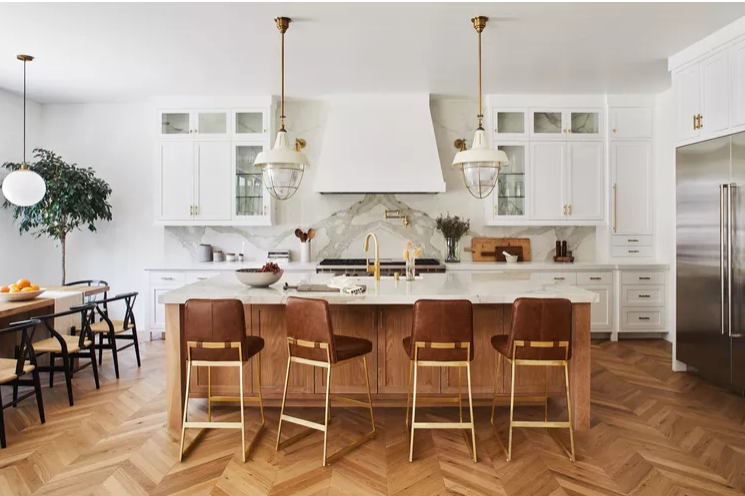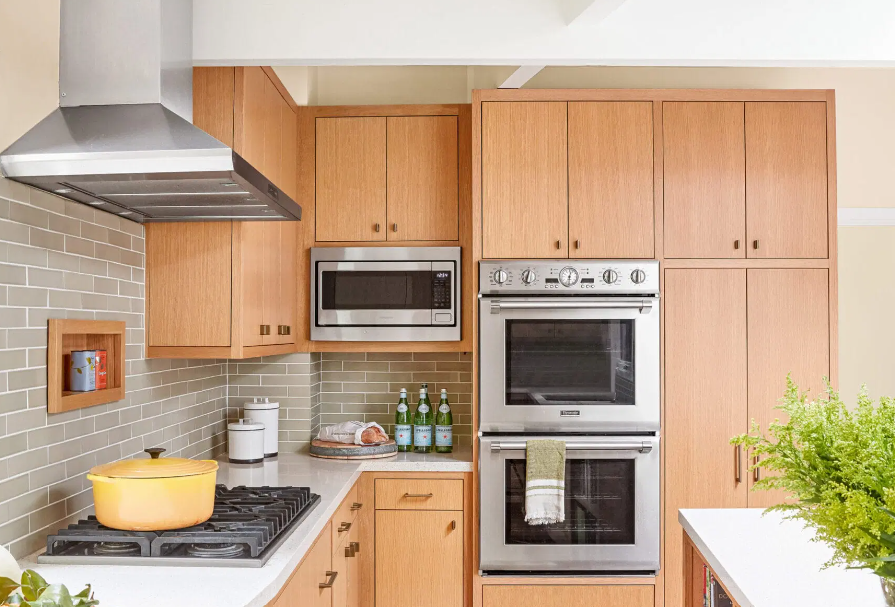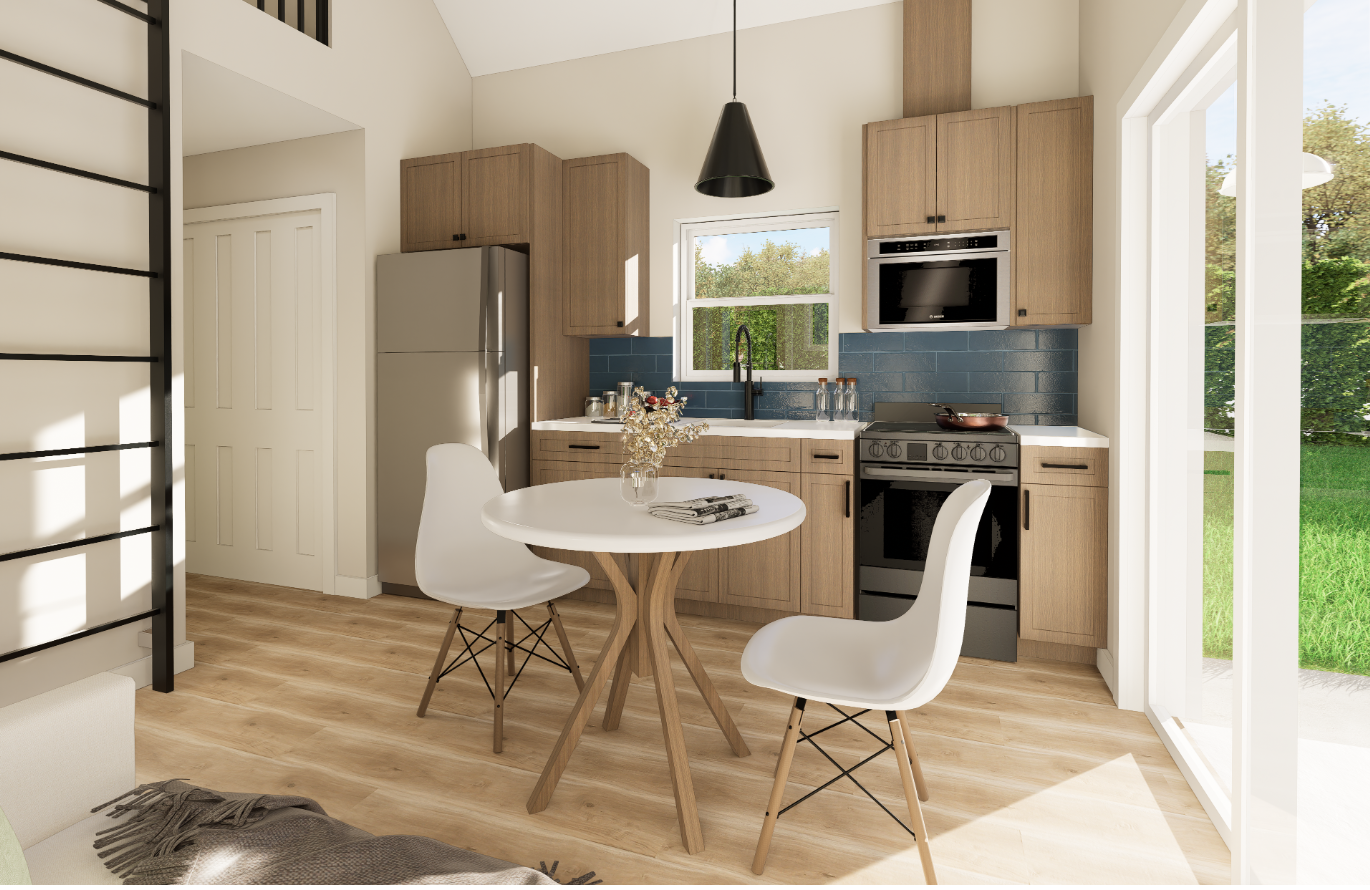ADU Knowledge
October 2, 2025
Open Concept vs. Galley: Choosing the Right ADU Kitchen Design

.png)
Schedule a free appointment with one of our ADU experts.
Get ADU QuoteOr call: (323) 591-3717
Open concept ADU kitchens remove walls, thereby creating a spacious, flowing area connected to living or dining spaces. Consequently, this layout maximizes natural light and encourages social interaction while cooking. Moreover, with careful planning, it balances storage, workflow, and aesthetics, making even small ADUs feel open, modern, and comfortable for daily use and entertaining guests.
In contrast, galley kitchens feature two parallel countertops, creating an efficient and compact workspace. The sink, stove, and refrigerator are all conveniently located within easy reach, maximizing workflow and storage space.

Open concept kitchens allow seamless integration between the cooking area and adjoining living spaces. Consequently, this layout enhances visual continuity and flexibility, making it easier to arrange furniture or dining areas. Moreover, it improves traffic flow, ensuring the kitchen feels functional, accessible, and comfortable even in compact ADUs.
In addition, these kitchens benefit from strategic zoning and multitasking areas. For example, designers can create dedicated prep, cooking, and cleanup zones without the need for physical barriers. By incorporating vertical storage, corner cabinets, and movable islands, efficiency is maximized.
Open-concept ADU kitchens offer a sense of openness that makes small spaces feel larger and more inviting. Consequently, by eliminating walls between the kitchen and living or dining areas, natural light is able to spread throughout the space. This design enhances the aesthetic of your ADU and encourages seamless interaction between family and guests.
Key benefits of this layout include:
Furthermore, open concept kitchens offer flexibility in furniture placement and multitasking areas. Designers can create zones of cooking, prepping, and dining without physical barriers while maintaining safety and efficiency. This layout improves traffic flow and accessibility, and allows creative storage solutions like movable islands or wall-mounted shelving to maximize space utilization.
Galley kitchens feature two parallel countertops or walls, thereby creating a compact and highly efficient workspace. Consequently, the sink, stove, and refrigerator remain within easy reach, forming an effective work triangle. This layout is perfect for narrow ADUs, maximizing storage and countertop space without sacrificing functionality or code compliance.
Moreover, these kitchens excel in workflow and organization. Cabinets, drawers, and shelving can be strategically arranged to provide ample storage while keeping countertops clear and uncluttered. Additionally, proper lighting, ventilation, and appliance placement enhance both safety and usability. Overall, a well-designed galley kitchen combines efficiency with convenience, making it ideal for daily cooking and small-space living.

Galley ADU kitchens are designed for efficiency and functionality, making the most of limited space. Consequently, by positioning countertops, appliances, and storage along two parallel walls, this layout reduces unnecessary steps while cooking. It allows for a highly organized workspace where everything is within easy reach, making it ideal for narrow ADUs or compact layouts.
Key advantages of galley kitchens include:
Moreover, galley kitchens support clear workflow and safety. Proper lighting, ventilation, and strategic appliance placement prevent the space from feeling cramped.
Choosing between open concept and galley ADU kitchens ultimately depends on your priorities, available space, and lifestyle. While open concept layouts emphasize spaciousness, natural light, and social interaction, galley kitchens, on the other hand, focus on efficiency, compact workflow, and maximizing storage. Therefore, understanding these differences clearly helps you select the layout that fits your ADU best.
Key comparison points include:
By carefully evaluating your property’s dimensions, traffic flow, and lifestyle needs, you can confidently determine which layout best balances functionality and aesthetics. Furthermore, designers at Gather ADU help you visualize each option, ensuring that your kitchen is not only practical and visually appealing but also fully compliant with California codes, saving you time and avoiding costly revisions.
Regardless of whether you choose an open concept or galley layout, certain design principles are essential to ensure your ADU kitchen is both functional and fully code-compliant. For example, proper placement of the sink, stove, and refrigerator creates an efficient work triangle, while adequate countertop space, storage, and lighting enhance usability and safety.
Key design considerations include:
Additionally, other critical considerations involve accessibility, ventilation, and appliance placement. For instance, pathways should remain unobstructed, outlets and switches must meet code requirements, and range hoods or exhaust fans should be installed correctly.

Building an ADU kitchen in California requires strict adherence to local permits and code compliance. Therefore, proper documentation is essential to ensure your project meets state and municipal regulations, including plumbing, electrical, ventilation, and safety standards. Additionally, securing permits before construction prevents costly delays, fines, and inspection failures while protecting the long-term legality of your ADU.
Moreover, compliance also involves following clearances, fixture placement, and appliance requirements. Inspectors carefully review layouts, materials, and utility connections to confirm safety and functionality. By working with experienced designers, you can streamline the approval process, ensuring your kitchen is fully permit-ready and meets all code requirements without unnecessary revisions or complications.
Planning an ADU kitchen can feel complex due to strict California codes and space limitations. Therefore, by starting your project with Gather ADU, you gain expert guidance to design a functional, stylish, and compliant kitchen from the very beginning.
Furthermore, our team handles layouts, appliance placement, finishes, and permit-ready plans. As a result, we ensure your kitchen passes inspections the first time, saves you time and money, and provides a space that’s efficient, comfortable, and perfect for daily use or entertaining.

Yes, you do. In California, ADUs must have a functional kitchen that includes a sink, cooking appliance, countertop, and storage. Without these essentials, your ADU may fail inspection or not qualify as a legal dwelling unit, which can ultimately delay your project.
Absolutely, Compact stoves, refrigerators, and microwaves are allowed as long as they meet safety and energy codes. Moreover, these smaller appliances save space while maintaining functionality, making them ideal for ADUs with limited space without compromising usability or code compliance.
Ventilation is essential; California requires exhaust fans or range hoods to remove smoke, moisture, and odors. Proper ventilation not only prevents health hazards but also ensures inspection approval and reduces fire risk, making it a critical feature for safety and code compliance.
Placement requires careful planning. Consider plumbing, electrical access, and workflow efficiency. For instance, kitchens near existing utility lines reduce installation costs. Additionally, proper positioning ensures functional work triangles, compliance with codes, and convenient daily use while minimizing inspection issues or construction complications.
Hiring a designer brings significant benefits. They ensure your ADU kitchen meets California codes, maximizes efficiency, and passes inspections. Furthermore, designers optimize layouts, select compliant appliances, and create permit-ready plans.
.png)
Not sure where to start with your ADU project?